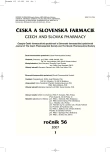Consumption of old and new antiepileptic drugs in the Czech Republic in 1999–2004
Authors:
E. Tlustá; D. Ulmanová 1; Z. Vitásek 1; J. Vlček
Authors‘ workplace:
Univerzita Karlova v Praze, Farmaceutická fakulta v Hradci Králové, Katedra sociální a klinické farmacie
; Zaměstnanecká pojišťovna Škoda, Mladá Boleslav
1
Published in:
Čes. slov. Farm., 2007; 56, 37-41
Category:
Original Articles
Overview
Trends in antiepileptic drug (AEDs) consumption in the period from 1999 to 2004 in the Czech Republic were assessed in this study. The data from extramurally prescribed, reimbursed AEDs were obtained from the Czech Health Insurance Company Škoda Mladá Boleslav. The AEDs utilization was assessed according to ATC/DDD methodology on the fourth and fifth level of the ATC classification and expressed as the number of defined daily doses per 1000 insured per day (DDD/TID). During the study period, the AEDs consumption increased by 130 %; 76 % of which consisted of new AEDs. The most frequently prescribed drugs were carbamazepine and valproate. It correlates well with recent guidelines, where carbamazepine and valproate are licensed as the first line therapy in the treatment of epilepsy. The utilization of barbiturates and hydantoines is decreasing. Gabapentin, lamotrigine and topiramate were the most frequently prescribed new AEDs. The total cost of AEDs increased three times, 84.5 % of this increase accounted for new AEDs. The outcomes are in agreement with current recommendations. The AEDs consumption follows trends similar to those in other countries with a fast shift to new antiepileptic drugs.
Key words:
antiepileptic drugs – ATC-DDD methodology – drug utilization
Labels
Pharmacy Clinical pharmacologyArticle was published in
Czech and Slovak Pharmacy

2007 Issue 1
Most read in this issue
- Extrusion/spheronization: an important method for the production of the pellet dosage form
- The influence of the extrusion die on pellet characteristics
- Deep vein thromboembolism in malignant diseases
- Constituents of Lilium candidum L. and their antioxidative activity
